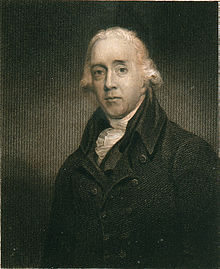Nicholas Pocock
Nicholas Pocock (born May 2, 1740 in Bristol , † March 19, 1821 in Maidenhead ) was a British painter who was particularly famous for his drawings of naval battles.
biography
Pocock's father, also named Nicholas Pocock, was a merchant and seaman in Bristol who is believed to be related to the Pococks of Chieveley by marriage . The younger Pocock was also the brother of the future captain Isaac Pocock .
From 1757 Pocock was apprenticed to his father; he completed his training by going to sea. His father died in 1759, so that Pocock, the eldest of three sons, had to take care of the family's income.
With little education, the younger Nicholas Pocock served on a ship and was also an employee of the merchant Richard Champion . On a Champions ship, the Lloyd, Pocock sailed for South Carolina . Pocock later commanded another Champions ship, the Minerva. At sea, Pocock's talent for drawing was discovered, which was reflected in his illustrations for a marine magazine. Champion was also a great fan of Pocock's art.
Pocock sent his first oil drawing to the Royal Academy in 1780 for further training, but the drawing arrived too late for an application, which would make future studies possible only in the distant future. However, Pocock received a letter from Sir Joshua Reynolds recommending that he continue his education. Two years later a painting by Pocock was exhibited at the Royal Academy for the first time, it was entitled A View of Redcliff Church from the Sea Banks . Until 1815 he regularly exhibited pictures in the Royal Academy, mainly dedicated to these naval battles.
From 1789 Pocock lived in London , from 1796 in Westminster, where he maintained contact with many high dignitaries of the British Navy.
In 1804 Pocock founded the Watercolor Society , which was temporarily triggered in 1812, but his commitment in the form of lasted until 1817. While he worked in the association, he exhibited a total of 182 works, more than in the Royal Academy.
Pocock moved from London again in 1817 and later retired for health reasons at his eldest son's residence in Maidenhead , where he died in 1821. Like his brother Isaac, Nicholas Pocock was buried in the family crypt at Cookham Church.
Despite his landscape paintings, Pocock received a lot of recognition, especially for his scenes of naval battles.
Works (selection)
Individual evidence
- ↑ Cordingly, Pocock, p 15
literature
- David Cordingly: Nicholas Pocock 1740-1821. Conway. London 1986. ISBN 0-87021-993-6 .
Web links
- List of works in the National Maritime Museum, Greenwich, the largest collection of Nicholas Pocock's work
- Works in the British Museum
| personal data | |
|---|---|
| SURNAME | Pocock, Nicholas |
| BRIEF DESCRIPTION | British painter |
| DATE OF BIRTH | May 2, 1740 |
| PLACE OF BIRTH | Bristol |
| DATE OF DEATH | March 19, 1821 |
| Place of death | Maidenhead |





